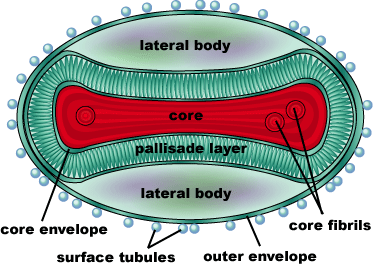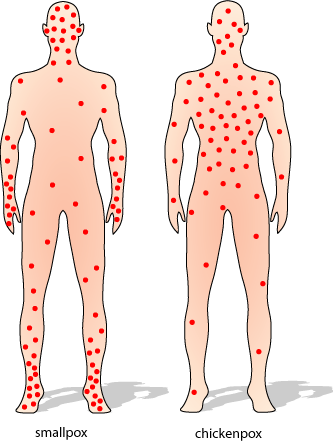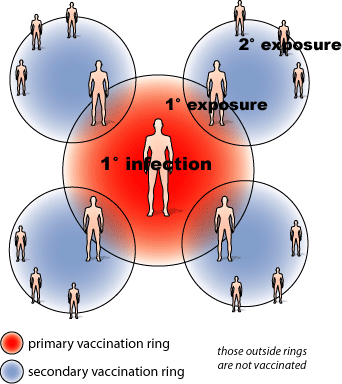SMALLPOX: THEN AND NOW
(August 2004)
Of all human infectious diseases, smallpox is believed to have resulted in more human deaths throughout history than from any other single pathogen. The causative agent of smallpox, Variola virus, was eradicated from natural existence in 1977, through a global vaccination effort administered by the World Health Organization (WHO). Currently, the only official stores of Variola are in freezers of two research sites: one at the Centers for Disease Control (CDC) in Atlanta, and one at the VECTOR research facility in Russia. The story of smallpox is one with many chapters, of which the end has not been written.
Molecular and Clinical Features of Smallpox
Variola is subtyped into two distinct species, v. major and v. minor, which are both infectious to humans. v. major was responsible for the vast majority of human deaths(~30% mortality rate), as v. minor only causes death in about 1% of cases. The Variola virus is a complex, enveloped, double-stranded DNA virus (figure 1).

It is believed that the virus first infected humans at some point between 3000-12,000 years ago, likely crossing the species barrier by zoonotic spread. It is believed that natural mutations to the viral DNA due to replication errors caused Variola to change its molecular structure such that it could no longer maintain viability in any other animal host or environmental reservoir. In humans, Variola gains entry to the body through “mucous membranes” (eyes, mouth, nose, throat and lungs) or into open cuts or sores on the skin. It is most commonly spread in the air through coughing or sneezing, and can also be spread by contact with the pus of the characteristic ‘pox’ that form on peoples faces, limbs, and to a lesser extent on the torso (Fig.2). The clinical course of smallpox is one that can be easily identified to those who are trained to recognize its characteristic features.The incubation period of smallpox is commonly 10-14 days, after which time the visual cues for diagnosing the infection become evident. Initially people develop non-specific, flu-like symptoms (fever, malaise, vomiting, headache etc.). Infection then progresses to the characteristic rash for which the disease is named. These lesions progress through stages termed: macules, papules, vesicles and pustules before turning into crusted scabs. These scabs fall off after 3-4 weeks, leaving the patient with depigmented scars. Smallpox is unique from chickenpox or measles in that there are more lesions on the face and limbs than on the torso, termed centrifugal distribution, whereas chickenpox and measles tend to have a more centralized, centripetal distribution over the body (Fig 2.). Further, smallpox lesions all progress through the development stages at the same time, whereas the chickenpox and measles can have lesions at different stages of progression on the body concurrently. Death from smallpox normally occurs between the 5th and 7th days of clinical infection and is due to blood loss and shock from hemorrhagic infection of the mucous linings inside the body.

Vaccination & Global Eradication
To date, Variola is the only virus that has been eradicated from natural existence due to human intervention. The reasons more viruses (and bacteria) have not been eradicated is due to the requirement that three criteria must be met before targeting an infectious agent for eradication:
1. The pathogen should only have a reservoir in humans (not animals or the environment).
2. An effective vaccine for the infection should be available such that humans can be protected from infection with high efficacy.
3. The disease should be easily diagnosable, without the potential to remain hidden from immune surveillance in a human host
Smallpox clearly suited these criteria, which is why it could was eradicated. Measles and Polio are other agents that fit these criteria, and efforts are currently underway for their global eradication as well.
The vaccine that was successfully used to protect people from smallpox disease was the world’s first scientifically documented vaccine, developed by the English physician, Dr. Edward Jenner. Dr. Jenner had noticed that dairymaids seemed to have an abnormally high resistance to smallpox infection. The correlation that he hypothesized was that these dairymaids, who were commonly exposed to cowpox lesions, must have developed a resistance to smallpox due to previous cowpox exposure. As cowpox only causes a mild disease in humans, it seemed a fitting means of protecting people against the much more lethal smallpox. So, in a wholly unethical experiment by today’s standards, Dr. Jenner used the cowpox pus from a dairymaid, Sarah Nelmes, to inoculate into the arm of a young boy, James Phipps, who had not had exposure to either disease. After a few months, Dr. Jenner used the pus of a victim of smallpox to inoculate young James’ arm. To the relief of everyone involved, James didn’t become infected with smallpox. It seemed he had become immune from the earlier cowpox exposure. Using the Latin word for cow “vacca”, Jenner termed this practice ‘vaccination’. Thus began the eventual use of vaccines worldwide [4].
Even with all the tools for global eradication seemingly in place, the program took over ten years and the efforts of hundreds of thousands of field workers. In an effort to makethe best use of Vaccinia vaccine, the system of “ring vaccination” was employed (Fig.2). In this system, each person who is identified to have been infected is considered to be at the center of a “primary ring”. This primary ring is made up of all the contacts that infected person had made of the last two weeks (or more). These people are considered exposed, though not necessarily infected. A number of secondary rings are then developed, as it is important to identify all of the recent contacts of those members in the primary ring. Ideally, all of these identified people should be isolated or quarantined, and all should receive a vaccination if it is not contraindicated. People who are contraindicated for Vaccinia vaccine include those who have certain skin problems such as eczema, people who are immunosuppressed due to medical treatments (e.g. cancer therapies, transplant recipients) or those who are pregnant.
Reasons For Current Threats
All of this information would only serve as a history lesson if there were not fears that smallpox may once again be released into the environment as a biological weapon. These fears stem from the fact that there are concerns that the two official stocks of Variola in the US and Russian labs may not be the only sources of Variola in the world today.
The first documented use of smallpox disease as a weapon was by British General Jeffrey Amherst, in 1763, in the Niagara region during British settlement. Amherst felt that the spread of blankets used by smallpox victims to the Natives of the area would be an effective means of reducing the Native population [7]. Several outbreaks are said to have resulted from this method of offensive smallpox spread. Throughout the following centuries, many attempts were made to use biological agents in the form of weapons, though effective means of spreading viruses and bacteria were never clearly identified. Many biological agents, including Variola, are sensitive to environmental factors such as UV light and variations in temperature and humidity [8]. Additionally, moral implications of biological attacks and the risk of infecting a country’s own people seemed to have helped deter the use of biological agents. Nevertheless, research into the potential use of offensive biological weapons continued in many countries well into the 20th century [2,5,6]. Recognizing the risk that biological weapons development posed to mankind as a whole, all of the countries who had the means do develop effective biological weapons signed a treaty at the “Biological and Toxic Weapons Convention” in 1972 [2]. The countries that had the most advanced biological weapons development programs at that time were the United States and Russia, common enemies in the so-called “Cold War”. However, while the United States had fully ceased it research of biological agents for offensive purposes years before that agreement, the Soviet Union continued with its biological weapons research in secrecy for many years thereafter. One of the main agents, which the Soviet’s had committed efforts to “weaponize”, was Variola. Some of the characteristics that make a biological agent a more effective weapon include: increased environmental stability, resistance to vaccines, and antibiotic resistance. Defection of some high-ranking Soviet scientists to the United States and England led to the eventual admittance by the Soviet Union that continued research efforts had been committed to developing biological weapons after they had signed the 1972 treaty. It was said by one Soviet scientist that at the height of the Cold War, the Soviet’s maintained four tons of Variola major that could be fitted onto missile warheads [8]. After conversion to modern-day Russia, the weapons program was finally put to rest in 1992 by president Boris Yeltsin. Even so, serious concerns remain that stocks of the Variola virus may have been removed by any number of Soviet scientists after they were laid off from their duties in the USSR and sought work in other countries. Presently, it is not known whether any viable Variola stocks exists outside of the official, WHO-overseen, stocks in the US and Russia. However, the potential exists.
Current Smallpox Outbreak Preparedness Planning
Currently, there are concerns that a smallpox outbreak, disseminated by aerosol means [5,6,8], could be a potential attack scenario undertaken by terrorist groups or those countries that support terrorist activity. If such a threat were realistic, the best defense against the spread of infection would be through the effective use of smallpox vaccination. However, potential complications arising from side effects of smallpox vaccination have raised concerns about what the best vaccination strategy is. With the current vaccine used, which is derived from the pus of cowpox lesions, 1 in 800 people have some sort of side effect, and 1 in 1-million recipients die from complications. As the actual risk of offensive smallpox dissemination is not known, it is difficult for governments to assess the risk vs. benefits of vaccination strategies. Options for vaccination use include: Mass Pre-Attack Vaccination, Mass Post-Attack Vaccination, Ring Vaccinations, and Selected Pre-Attack Vaccination with Ring Vaccination. The US is currently using the latter strategy, while Canada has prepared itself for Ring Vaccinations in the event of an outbreak. In the US, perceived high-risk groups such as the military, some health workers and possible “first-responders” (paramedics, police, firefighters) have been vaccinated or are being considered for vaccinations.

Conclusions
In the end, the decision by all governments on how best to protect their citizens from complications from smallpox (whether from vaccine side-effects or from actual smallpox infection) must rest on a sound analysis of risk (of attack) vs. benefits (of vaccination), while striving to minimize morbidity and mortality in the population as such.
Glossary
exposed – Status of an any individual who has been in contact with an infected individual during a period of infectiousness.
incubation period – The time period between infection and development of clinical symptoms.
infection – Introduction and growth of a pathogen inside an individual
isolation – Maintenance of infected individuals away from all other people who are not properly protected.
quarantine – Maintaining exposed individuals in an area separated from the non-exposed population.
zoonotic spread – Spread of pathogens from animal to human hosts.
References
1. Preston, R. The demon in the freezer. New York, NY. The New Yorker. 1999.
2. Rifkin J. 1998. The Biotech Century: Harnessing the Gene and Remaking the World. New York: Jeremy P. Tarcher/Putnam. 271p.
3. Drell SD, Sofaer AD, Wilson GD. The new terror, facing the threat of biological and chemical weapons. Stanford, CA. Stanford University Press, 1999.
4. Knobler, S. Biological threats and terrorism: assessing the science and response capabilities. Washington, DC. National Academy Press, 2002.
5. Nelson KE, Williams CM, Graham NMH. Infectious disease epidemiology, theory and practice. Gaithersberg, MD. Aspen Publishers, 2001.
6. Alibek K, Handelman S. Biohazard. Toronto, ON. Random House, 2001.
Additional Reading
- Drexler M. Secret agents: the menace of emerging infections. Washington, DC. Joseph Henry Press, 2002.
- Yount L. 2000. Biotechnology and Genetic Engineering. New York: Facts on File. 280p.
- Kiang KM & Krathwohl MD. Rates and risks of transmission of smallpox and mechanisms of prevention. J Clin Lab Med 2003;142:229-38.
- Bozzette SA, et al. A model for smallpox-vaccination policy. N Engl J Med. 2002;348:416-25.
- Moreno, JD. In the wake of terror: medicine and mortality in a time of crisis. Cambridge, MA. MIT Press, 2003.
- Halloran ME et al. Containing bioterrorist smallpox. Science. 2002;298:1428-32.
- Hull HF, Danila R, Ehresmann K. Smallpoxand bioterrorism: public health responses. J Lab Clin Med.2003;142:229-38.
- CDC Smallpox page
- Layne SP, Beugelsdijk TJ. Firepower in the lab: automation in the fight against infectious diseases and bioterrorism. Washington, DC. Joseph Henry Press, 2001.
(Art by Jen Philpot)